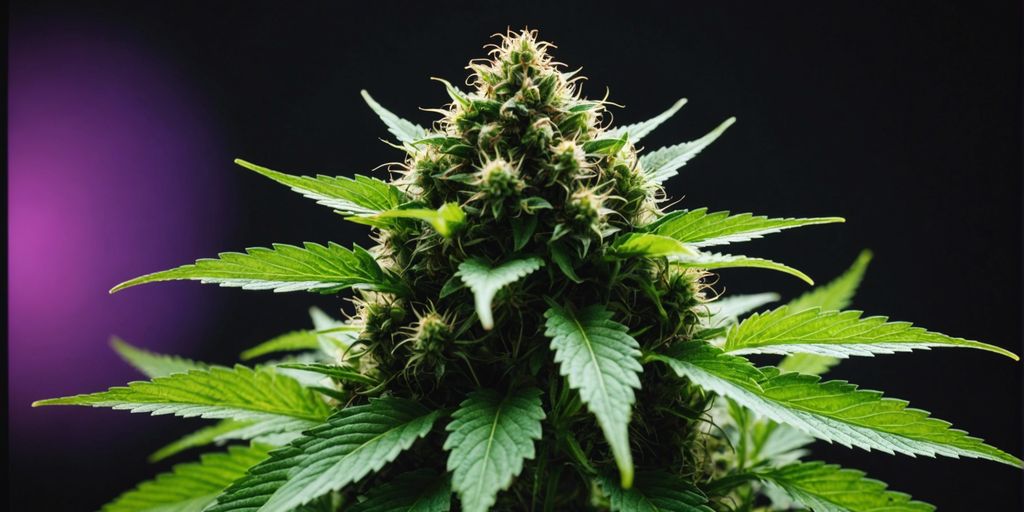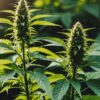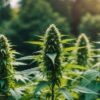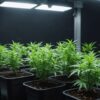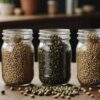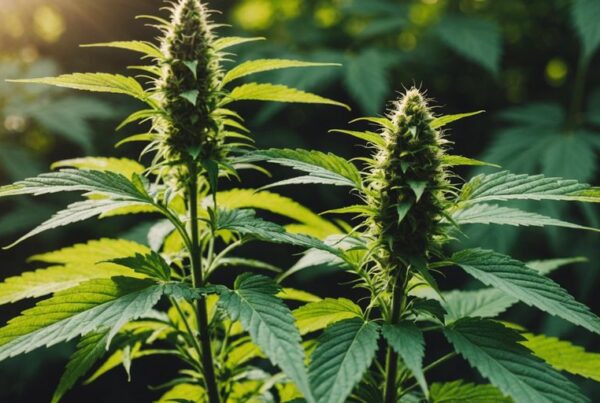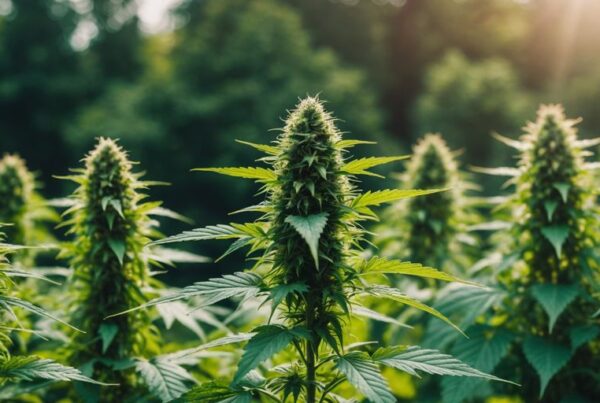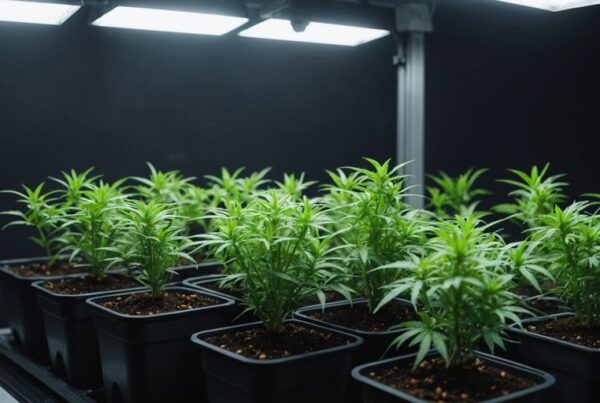Understanding and manipulating plant hormones allows for a controlled environment where cannabis plants can be developed with specific traits. This not only ensures consistency in plant quality but also significantly enhances the efficiency of breeding new cannabis varieties. Tissue culture, with the aid of these hormones, provides a tool for rapid multiplication and preservation of elite cannabis genetics, ensuring sustainability and advancement in cannabis cultivation.
Key Takeaways
- Plant hormones, or phytohormones, are crucial in directing the developmental pathways of cannabis plants.
- Auxins are essential for rooting, maintaining apical dominance, and can be synthetically produced for controlled growth.
- Cytokinins promote cell division, shoot growth, and delay leaf aging, balancing the effects of auxins.
- Gibberellins aid in stem elongation, flower development, and breaking seed dormancy.
- Abscisic acid and ethylene play significant roles in stress responses, such as water stress and fruit ripening, respectively.
Auxins: The Bossy Boots of Cannabis Growth
Rooting for Success: How Auxins Help
Alright y’all, let’s talk about auxins. These little fellas are perhaps the most crucial in marijuana tissue culture, primarily used to induce root formation and cellular differentiation. When you’re trying to get those roots to sprout, auxins are your best friend. They help in the elongation of cells and are vital in somatic embryogenesis, a process where a plant or embryo is derived from a single somatic cell. By adjusting auxin concentrations, tissue culturists can steer the development of cannabis cells from undifferentiated masses to organized tissues that form roots and shoots.
Auxins and Apical Dominance: Keeping the Top Spot
Now, auxins are also the reason your cannabis plant grows tall and proud. They promote apical dominance, which is just a fancy way of saying they keep the top bud as the boss. When a branch is bent horizontally, auxins will locate in higher concentrations on the unlit side of the branch, causing elongation of shaded plant cells and a bending of the branch toward the light. This is called positive phototropism. So, if you want your plant to grow straight and tall, you gotta keep those auxins happy.
Synthetic Auxins: The Lab-Made Helpers
Sometimes, Mother Nature needs a little help from the lab. That’s where synthetic auxins come in. These lab-made helpers mimic the natural auxins in your plant and can be used in rooting compounds. Just dip your cuttings in these compounds during vegetative propagation, and watch those roots grow like there’s no tomorrow. It’s like giving your plant a little boost of magic.
Remember, folks, auxins are the unsung heroes of your cannabis crop. They might be small, but they sure are mighty. Keep ’em happy, and your plants will thank you.
Cytokinins: The Cell Division Cheerleaders
Alright y’all, let’s talk about cytokinins, the unsung heroes of cannabis cultivation. These bad boys are all about cell division and shoot formation. Think of them as the cheerleaders at a high school football game, hyping up the team to keep pushing forward. They’re naturally found in places where rapid cell division happens, like root apices, shoot buds, and young fruits. And just like a good ol’ boy loves his mama’s cookin’, plants love their cytokinins.
Branching Out: Cytokinins and Shoot Growth
Cytokinins are like that buddy who always encourages you to take risks and try new things. They promote shoot growth and branching, making your cannabis plants bushier and more productive. If you’re looking to get more bang for your buck, cytokinins are your go-to. They work in tandem with auxins, but while auxins are the bossy boots, cytokinins are the supportive sidekicks.
Delay the Decay: Cytokinins in Leaf Aging
Nobody likes getting old, not even your cannabis plants. Cytokinins help delay the aging process in leaves, keeping them green and healthy for longer. It’s like giving your plants a shot of youth serum. So, if you want your plants to stay vibrant and productive, make sure they’re getting their fair share of cytokinins.
Balancing Act: Cytokinins vs. Auxins
In the world of plant hormones, balance is key. Cytokinins and auxins need to be in harmony for your plants to thrive. Too much cytokinin can lead to excessive shoot formation, while too much auxin can result in too many roots. It’s all about finding that sweet spot. So, keep an eye on your plants and adjust as needed to keep them happy and healthy.
Gibberellins: The Stretch Armstrongs of the Plant World
Alright y’all, let’s talk about gibberellins, the hormone that triggers marijuana plant seed production. These bad boys are like the Stretch Armstrongs of the plant world, making everything grow tall and strong. Gibberellins are growth-promoting phytohormones that act as general plant growth stimulants, playing an important role in many of the metabolic functions of vascular plants. They are produced in very young leaves, developing seeds, fruit, and roots. Gibberellins cause cell elongation during shoot growth and are involved in the regulation of dormancy. Commercially, gibberellins have been used to improve fruit size, prevent fruit russeting, and induce lateral branching.
Abscisic Acid: The Stress Reliever
Drought Drama: Abscisic Acid in Water Stress
Alright y’all, let’s talk about abscisic acid (ABA) and how it helps our green ladies handle a bit of dry weather. When the going gets tough, ABA steps in to close those stomata, halting transpiration and keeping precious water inside the plant. It’s like giving your cannabis a big ol’ drink of sweet tea on a hot summer day. This hormone is crucial to plants’ response to the stress of drought or cold, making sure they don’t wither away when the rain’s been scarce.
Seed Dormancy: The Plant Nap Time
Now, ABA ain’t just about dealing with drought. It’s also the reason your seeds don’t go sprouting at the wrong time. Think of it as the plant’s way of saying, “Hold your horses!” ABA promotes seed dormancy, ensuring they only germinate when conditions are just right. This is especially handy in the winter, preventing seeds from popping up only to get nipped by the frost. So, if you’re storing seeds, thank ABA for keeping them in a nice, deep sleep until you’re ready to plant.
Guard Duty: Stomatal Closure and Abscisic Acid
Ever wonder how your plants manage to survive those scorching Oklahoma summers? Well, ABA is on guard duty, making sure the stomata close up tight to prevent water loss. It’s like putting up a “No Trespassing” sign to keep the heat out. This hormone is a real lifesaver, especially when you’re using cannabis plant training techniques like LST and HST to optimize plant growth for higher yields. By manipulating growth to create a productive canopy, you’re also making sure your plants can handle the stress. The importance of training for a quality harvest can’t be emphasized enough, and ABA plays a big part in that success.
Ethylene: The Ripening Rockstar
Alright y’all, let’s talk about ethylene, the gas that makes your cannabis plants rockstars when it comes to ripening. This bad boy is produced naturally in all parts of the plant, especially in cells that are getting old or in fruit that’s ripening. It’s like the plant’s way of saying, “Hey, it’s time to party!” Ethylene is what gets the aging process going and makes your buds ready for harvest.
Fruit Ripening: Ethylene’s Encore
When it comes to fruit ripening, ethylene is the headliner. This gas is what makes your cannabis buds mature and ready for picking. It’s also used in commercial agriculture to ripen fruit that needs to be picked early for transport. So, if you’re into indoor cultivation techniques at Housman Horticulture, you might want to control climate with temperature and humidity to get the best out of your plants. Optimal conditions for growth stages are key, and choosing LED lighting for efficient plant growth can make a big difference.
Leaf Abscission: The Great Fall
Ethylene also plays a role in leaf abscission, which is just a fancy way of saying it makes leaves drop. This is especially noticeable in the fall when the leaves start to fall off the trees. In your cannabis plants, this can help get rid of old, unnecessary leaves, making room for new growth. It’s like a natural cleanup crew!
Stress Responses: Ethylene to the Rescue
Plants often ramp up ethylene production when they’re stressed out. Whether it’s salinity, low oxygen, or some other stressor, ethylene is there to help the plant cope. It’s like the plant’s own little stress reliever, making sure it can survive tough conditions. So next time your plants are looking a little worse for wear, remember that ethylene is working behind the scenes to keep them going strong.
Tissue Culture Triumphs: Hormones in Action
Alright y’all, let’s dive into the world of tissue culture and see how these plant hormones work their magic on our beloved cannabis plants. Tissue culture is like the high-tech version of cloning, but with a lot more precision and control. It’s all about creating a controlled environment where we can develop cannabis plants with specific traits. This not only ensures consistency in plant quality but also significantly enhances the efficiency of breeding new cannabis varieties. Understanding and manipulating these plant hormones is key to making this happen.
Conclusion
Alright folks, let’s wrap this up! If there’s one thing to take away from our deep dive into the world of plant hormones and cannabis cultivation, it’s that these tiny chemical messengers are the unsung heroes of your grow room. By mastering the art of hormone manipulation, you can turn your cannabis plants into the botanical equivalent of superheroes—stronger, faster, and more productive. Whether you’re cloning your favorite strain or trying to breed the next big thing, understanding these hormones is your secret weapon. So go forth, fellow cultivators, and may your buds be ever bountiful and your plants ever green!
Frequently Asked Questions
What are plant hormones and why are they important in cannabis cultivation?
Plant hormones, also known as phytohormones, are natural substances that influence physiological processes at low concentrations. They play a crucial role in directing the developmental pathways of plant cells, ensuring consistency in plant quality and enhancing the efficiency of breeding new cannabis varieties.
How do auxins contribute to cannabis growth?
Auxins are primarily synthesized in apical shoots and transported to roots, promoting cell division and root development. They help maintain apical dominance, ensuring the main shoot remains the primary growth point, and are also involved in cell elongation and inhibiting lateral branching.
What role do cytokinins play in cannabis cultivation?
Cytokinins promote cell division and shoot growth, delay leaf aging, and work in balance with auxins to regulate various growth processes. They are essential for branching and overall plant vitality.
How do gibberellins affect cannabis plants?
Gibberellins are involved in stem elongation, flower development, and seed germination. They help plants grow taller, facilitate the development of flowers, and break seed dormancy, thereby promoting germination.
What is the function of abscisic acid in cannabis plants?
Abscisic acid acts as a stress reliever for plants. It plays a vital role in water stress management by regulating stomatal closure, induces seed dormancy, and helps plants survive adverse conditions.
How does ethylene influence cannabis cultivation?
Ethylene is crucial for fruit ripening, leaf abscission, and stress responses. It helps in the natural aging process of plants, assists in shedding leaves, and enables plants to respond to environmental stresses effectively.

